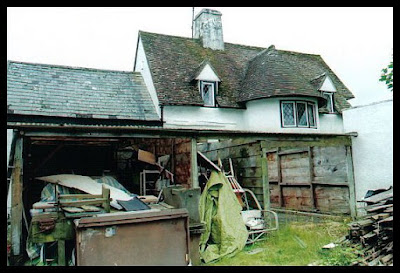Built circa 1830 as a coaching inn, the Three Horseshoes was used for changing horses and providing food and accommodation for coach travellers along the turnpiked road between Lyme Regis and Sidmouth. Apart from a Smithy, it was the only building on this stretch of the road at the time, due to the lack of piped water. However, hydraulic rams were being manufactured in Britain by the time it was built, and one was used to draw water from a nearby stream.
I only managed to discover a few interesting facts about the inn, including the above information taken from a transcript of a very interesting talk by John Torrance entitled 'The A3052 - A Road Through Time'. Containing a wealth of history about this particular part of the A3052, one fascinating aspect is that the inn was erected on the edge of the ploughed-down banks of a massive prehistoric earthwork, which was built by those who'd constructed the nearby Blackbury Castle hill fort. For anyone who'd like to read more from the transcript, I've put the link in below.
www.branscombeproject.org.uk/page18.html
Another interesting piece of info found elsewhere is that apparently the inn was used as a meeting place for local smugglers. I haven't been able to verify this, but if correct then this may have included the famous Jack Rattenbury, although he was captured in 1831 (the last of many captures!) and subsequently retired from smuggling on his release from prison. However, smuggling went on up until around 1850 in the area and Jack's son William continued in the 'family business', therefore he may have been one of the clandestine attendees.
This public house had been left empty for a good long while and became completely derelict. I'm not sure when it closed but planning permission was sought to build houses on the site in 2005, and subsequently left abandoned until recent demolition. I only visited once when it was open, which was some forty odd years ago when I was asked to do an illustration of the pub cricket team by the then landlord.
Difficult to get to without transport, I set out one day in 2008 for a walk to take in some other explores. I didn't intend to go this far but as I was already half way there, I just kept on walking and covered about ten miles in all! A bit scary along a busy route with no paths and fast traffic, but it was great to finally visit and it also gave me the opportunity to take photos of the Gilbart-Smith Memorial on the way. The inn was still there in 2012, at the time of writing this on my now defunct website, albeit a lot more derelict and with the addition of some houses built in the former pub car park.
There wasn't any access inside, but the exterior was interesting (which is my favourite bit of buildings anyway), along with the bonus of a few surprises.
Around the rear an adjacent wing ran along what was once the pub garden.
A wooden staircase at the rear with faded signs (above), including one for an adventure playground which is no longer there.
Adjoined to the adjacent wing at the rear I found this rather lovely Arts & Crafts house in the corner. The pub and accommodation wing have only recently been demolished, the site developed for housing. However, this attractive house has been left, hopefully to be renovated for use.
And behind that, the rear of the house with a fab turretted bay.
The trundly thing above is a rotovator, if I remember correctly.
There were loads of interesting bits and pieces stacked in and around the sheds behind the house. Below, a sign for Devon Cream Teas amongst old wooden chairs.
For anyone who doesn't know, a cream tea is a speciality food of Devon, consisting of scones lathered in jam and clotted cream with a pot of tea. The scones are sweet and contain a few scattered raisins and the clotted cream is a thick cream which has been steam heated then left in shallow pans to cool slowly, forming a crusty top. Absolutely delicious! In Cornwall their tradition is to put the jam on first and then the cream but in Devon it's cream first and topped with the jam.
A discarded lampost, above, and some wrought iron panels, below.
And finally, having walked such a long distance, I couldn't leave without climbing the outside stairs up to the roof for a photo. I'm horrendously acrophobic, and the wooden steps felt spongey - which didn't help - but I managed to get far enough to take three photos.
After that, I walked back and took the turning down into the village of Beer. I was badly aching by then, managed to limp into the village as a bus came around the corner and I caught it just in time to get back to Seaton. I was rather pleased about that! ;)
A final photo, and farewell, of the old pub carpark.

































No comments:
Post a Comment